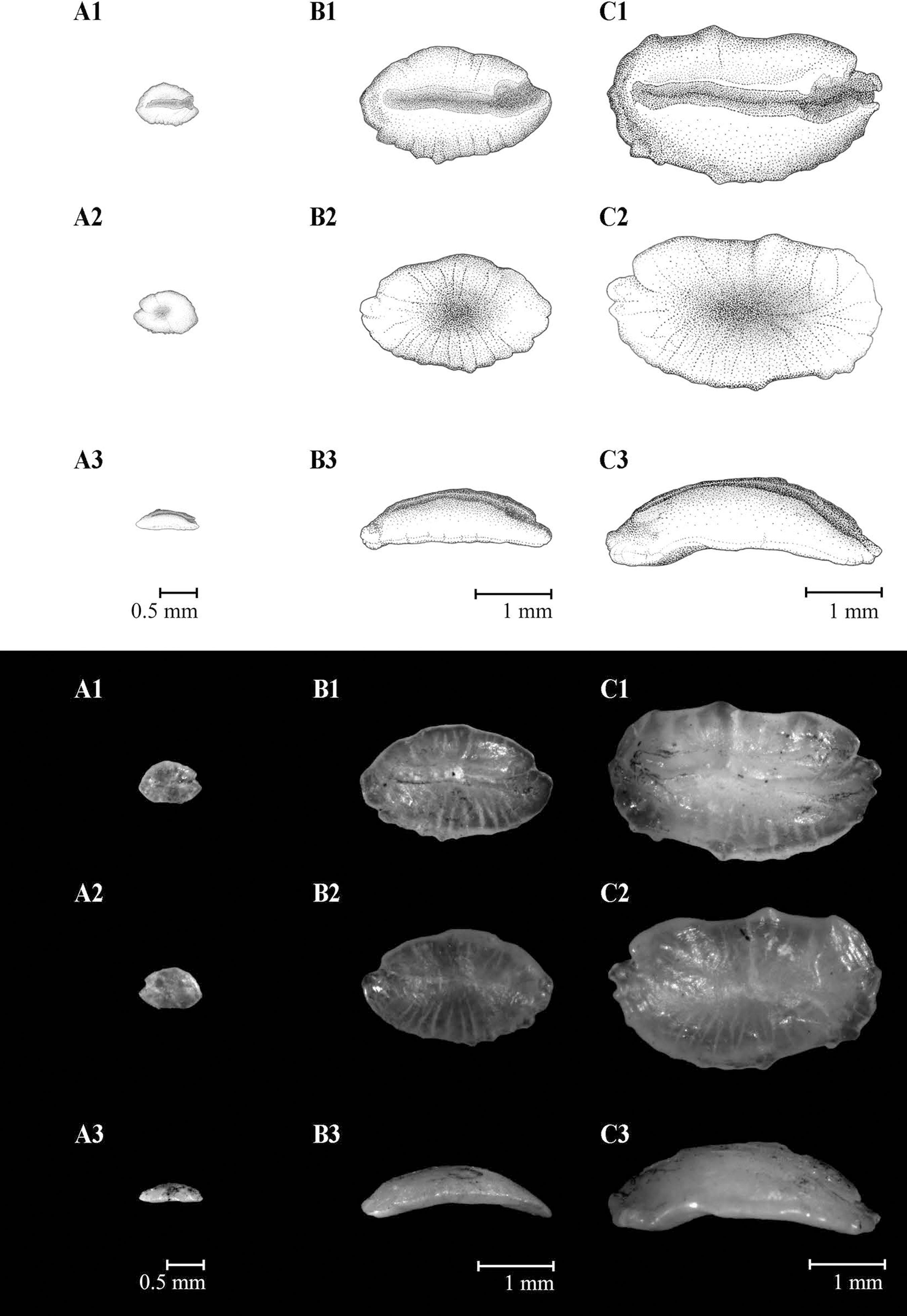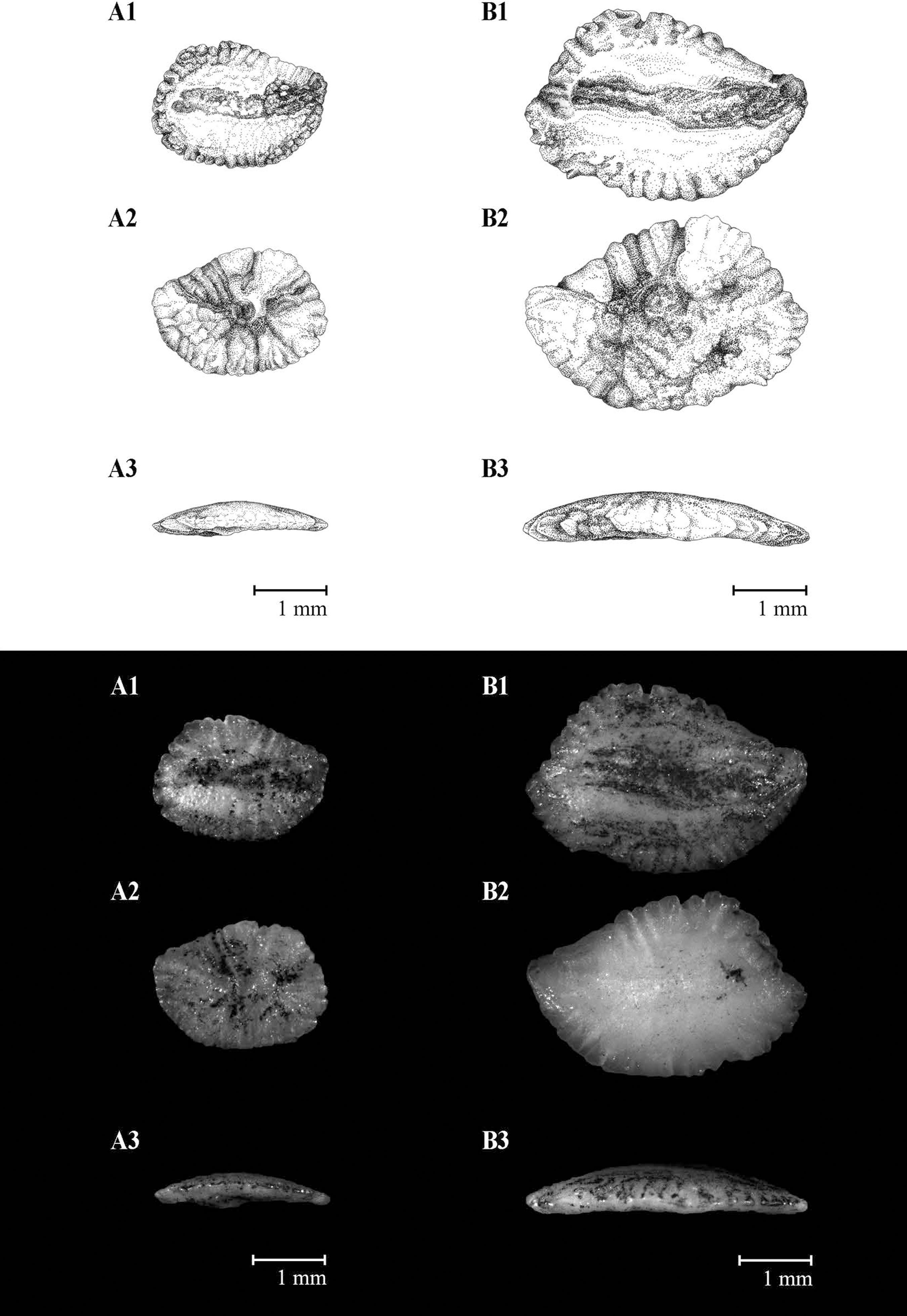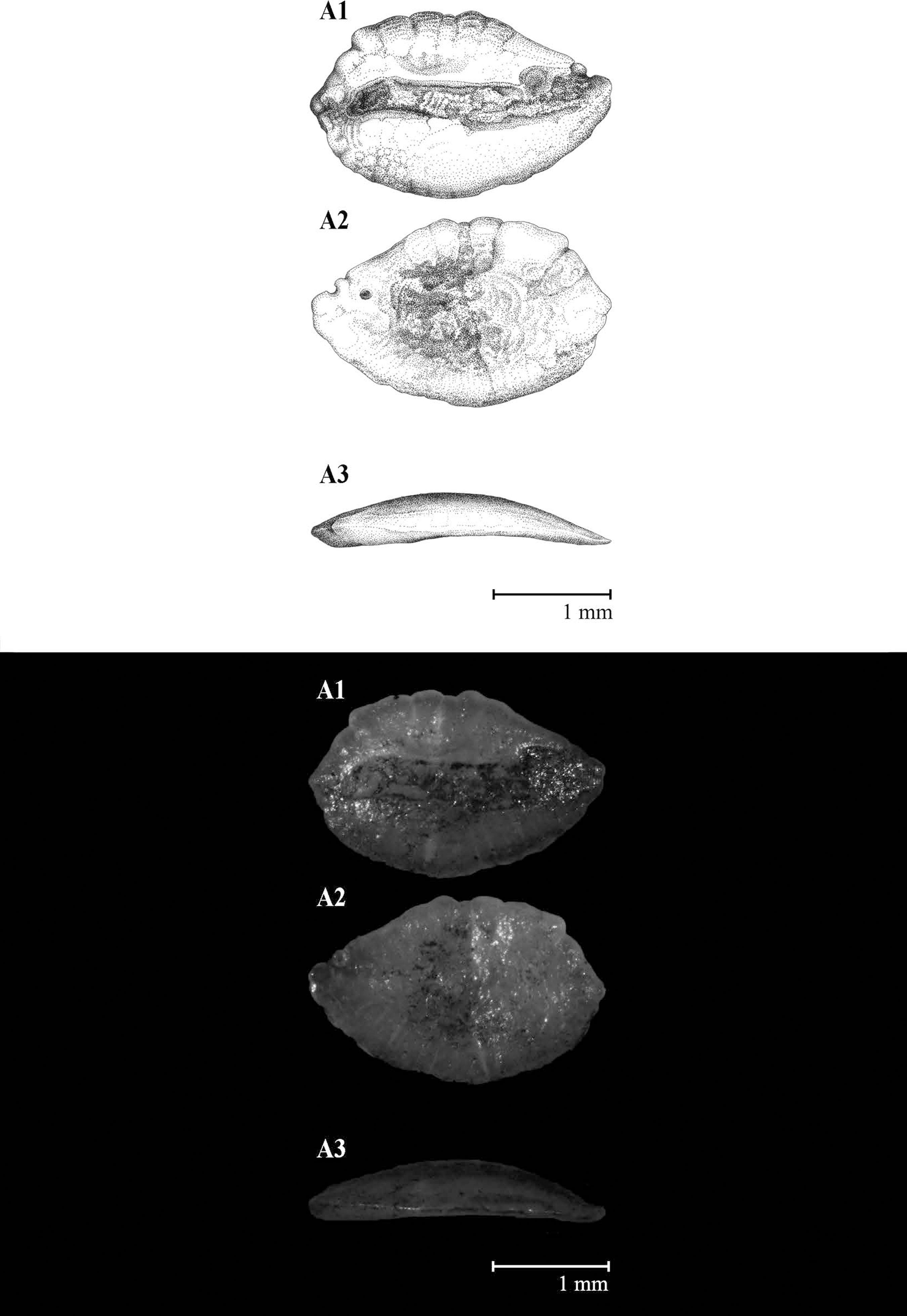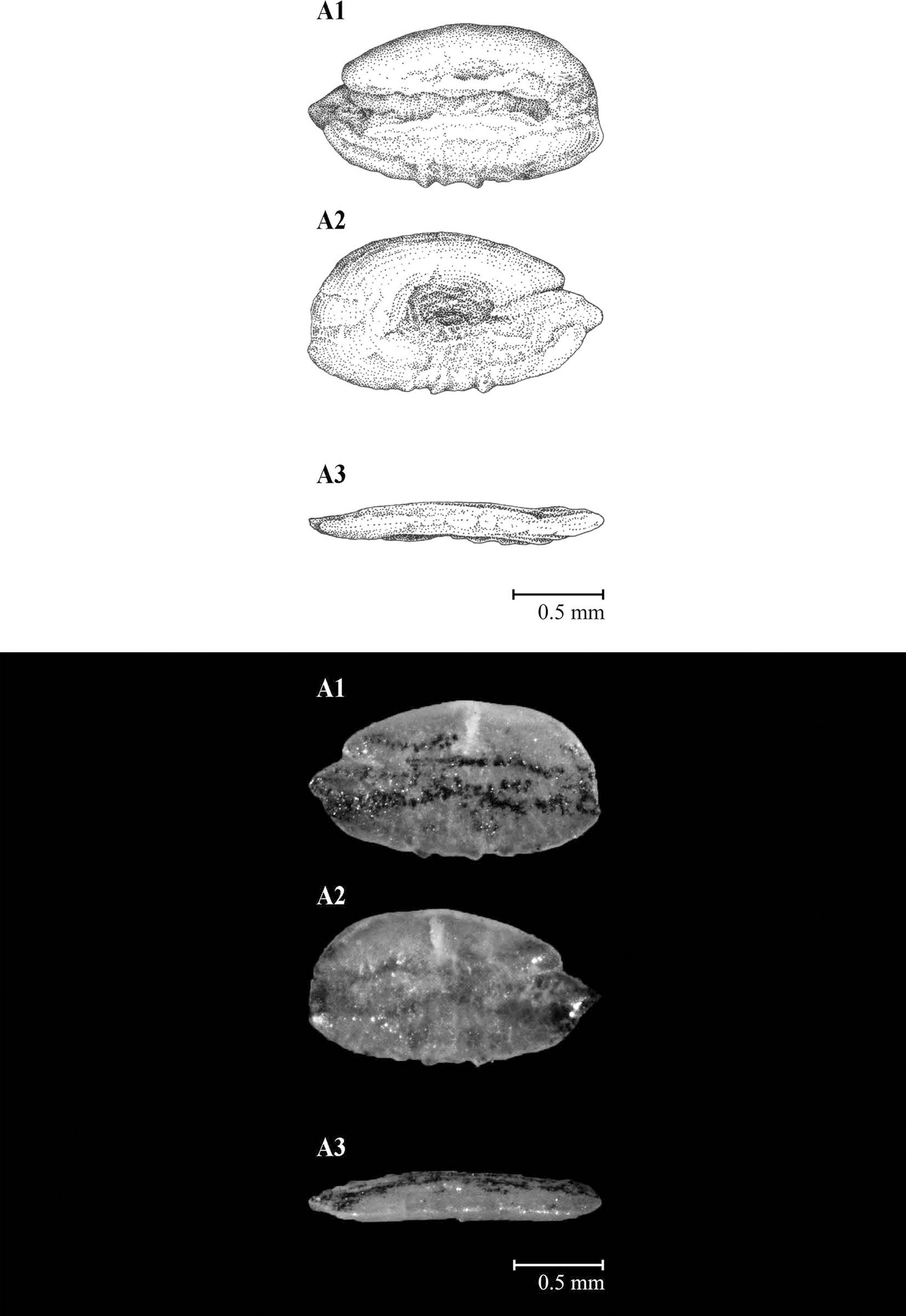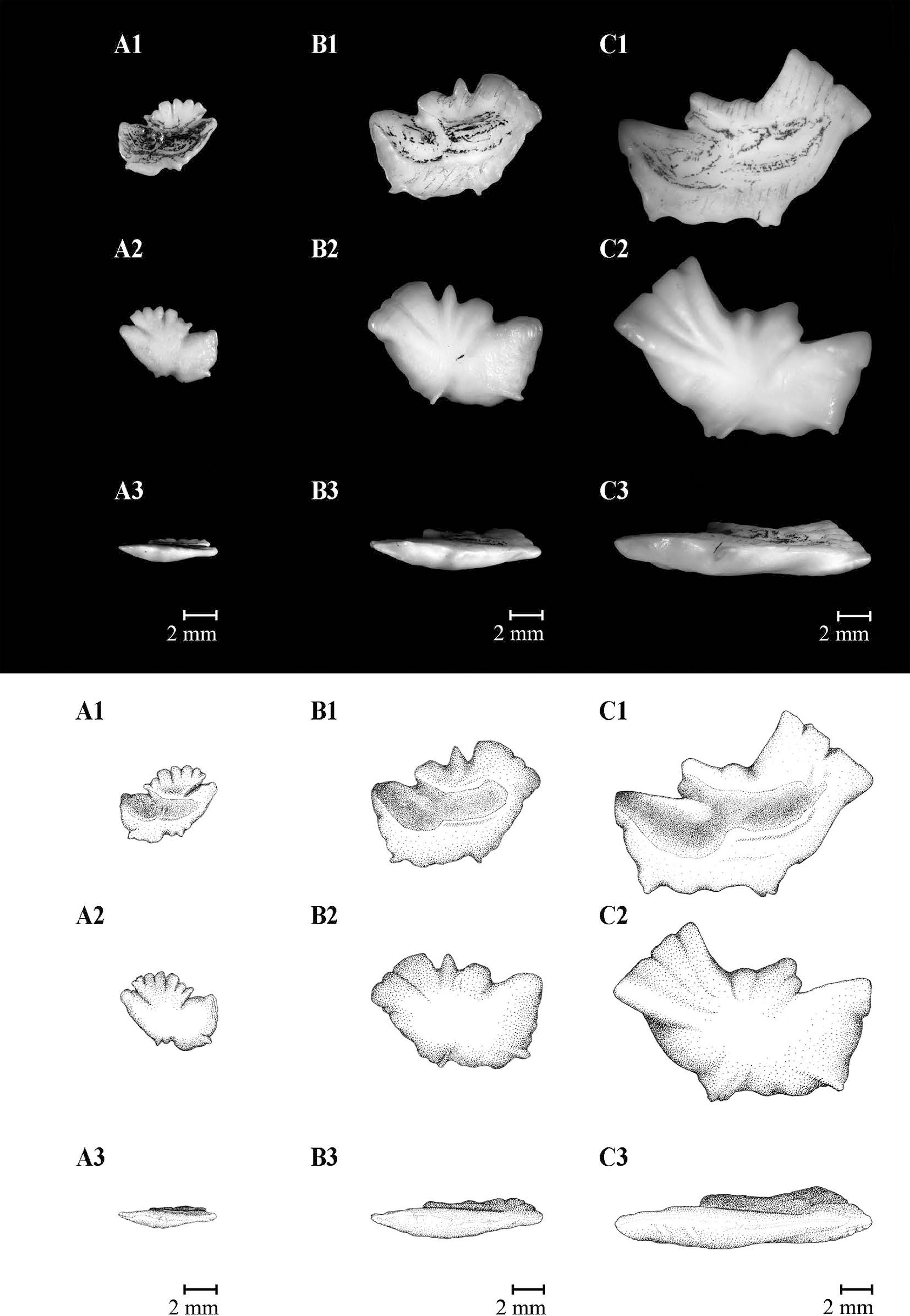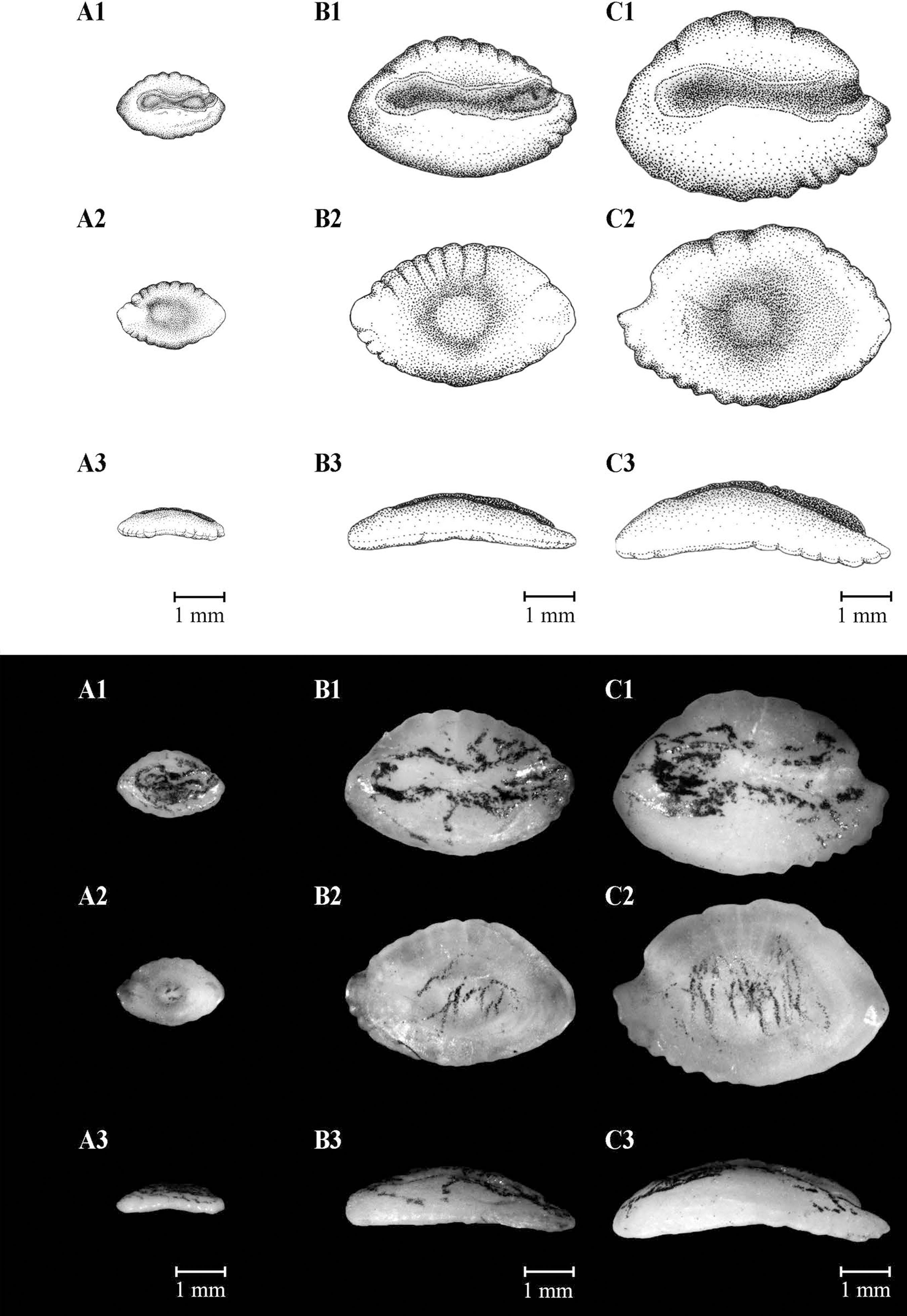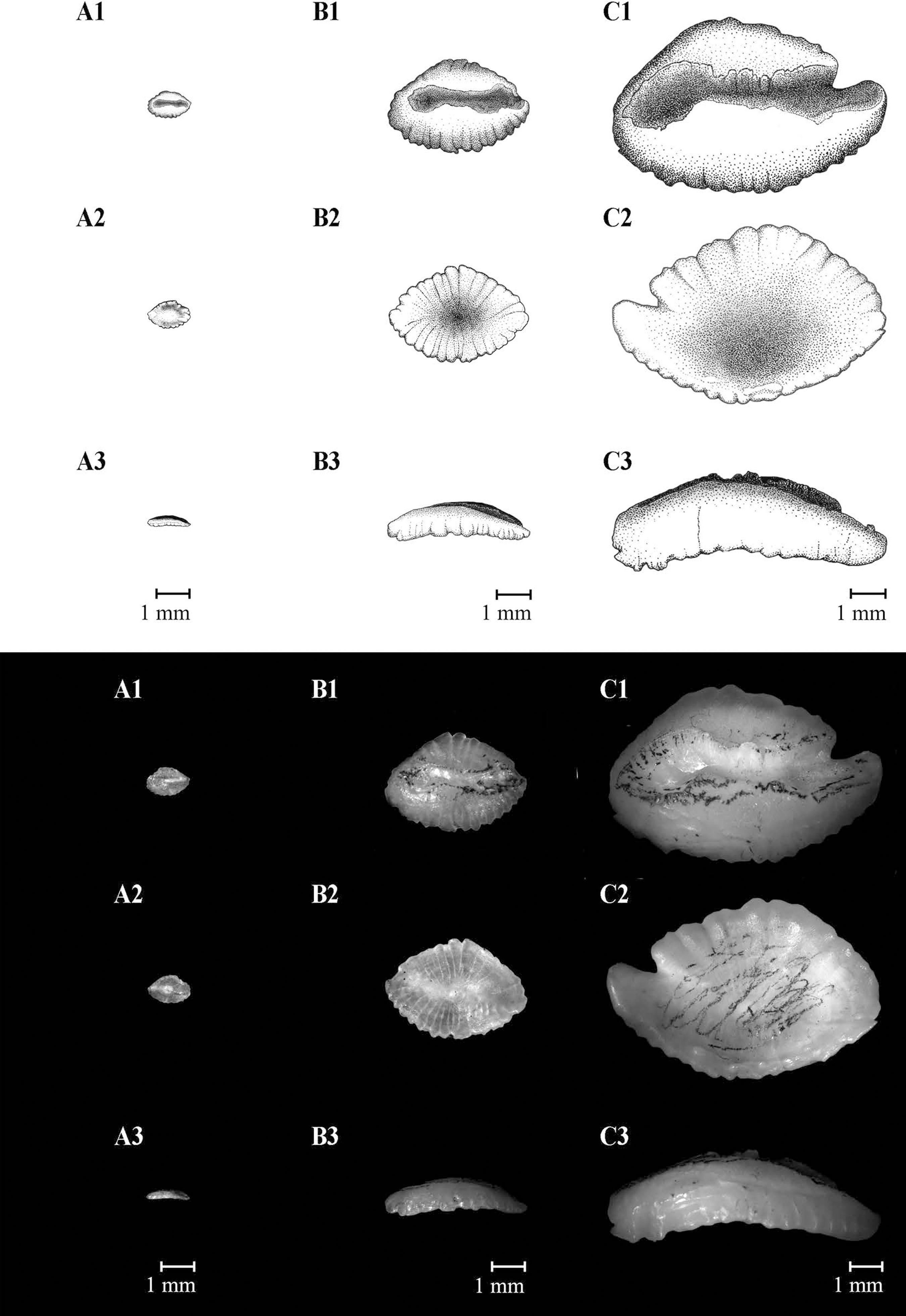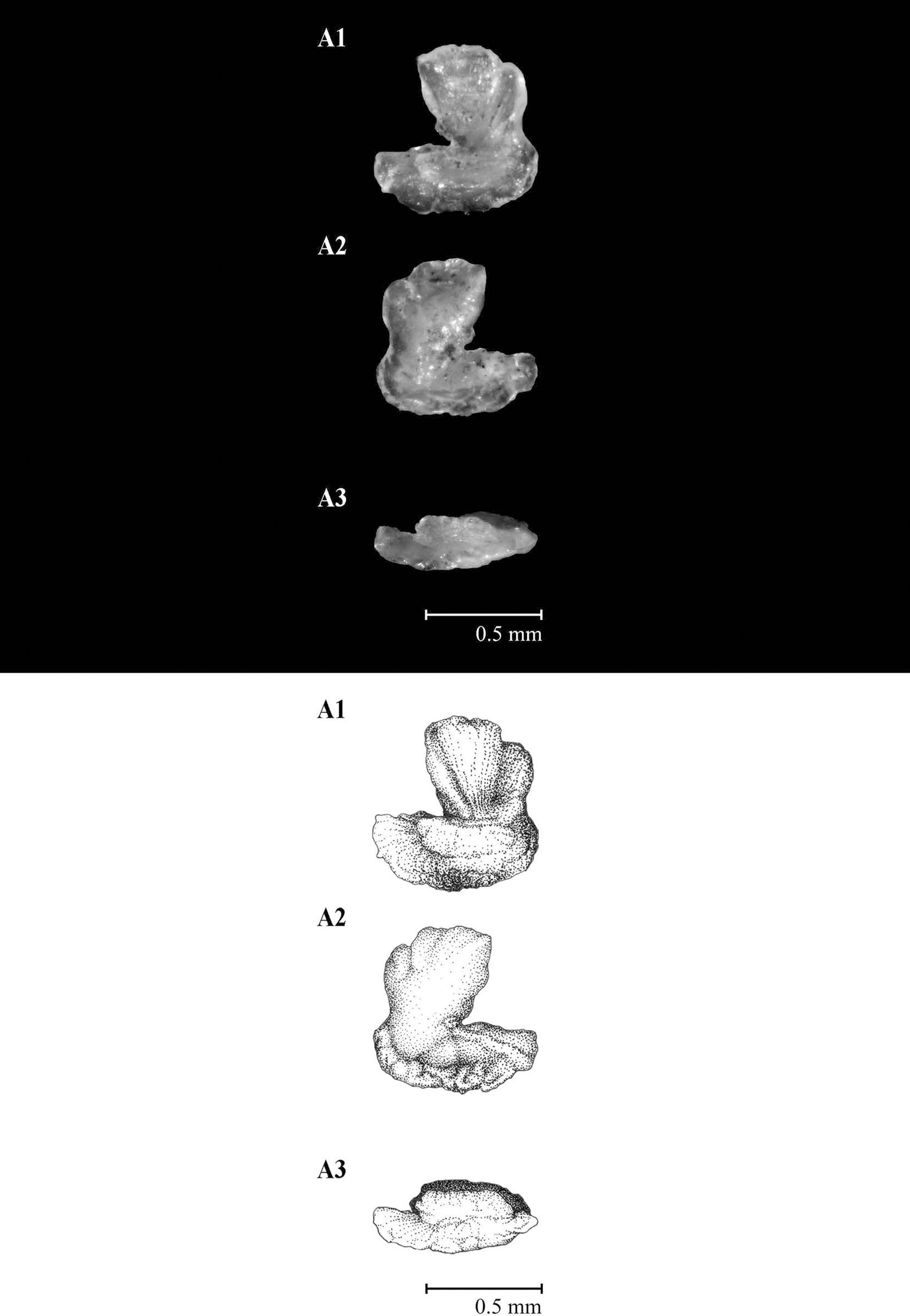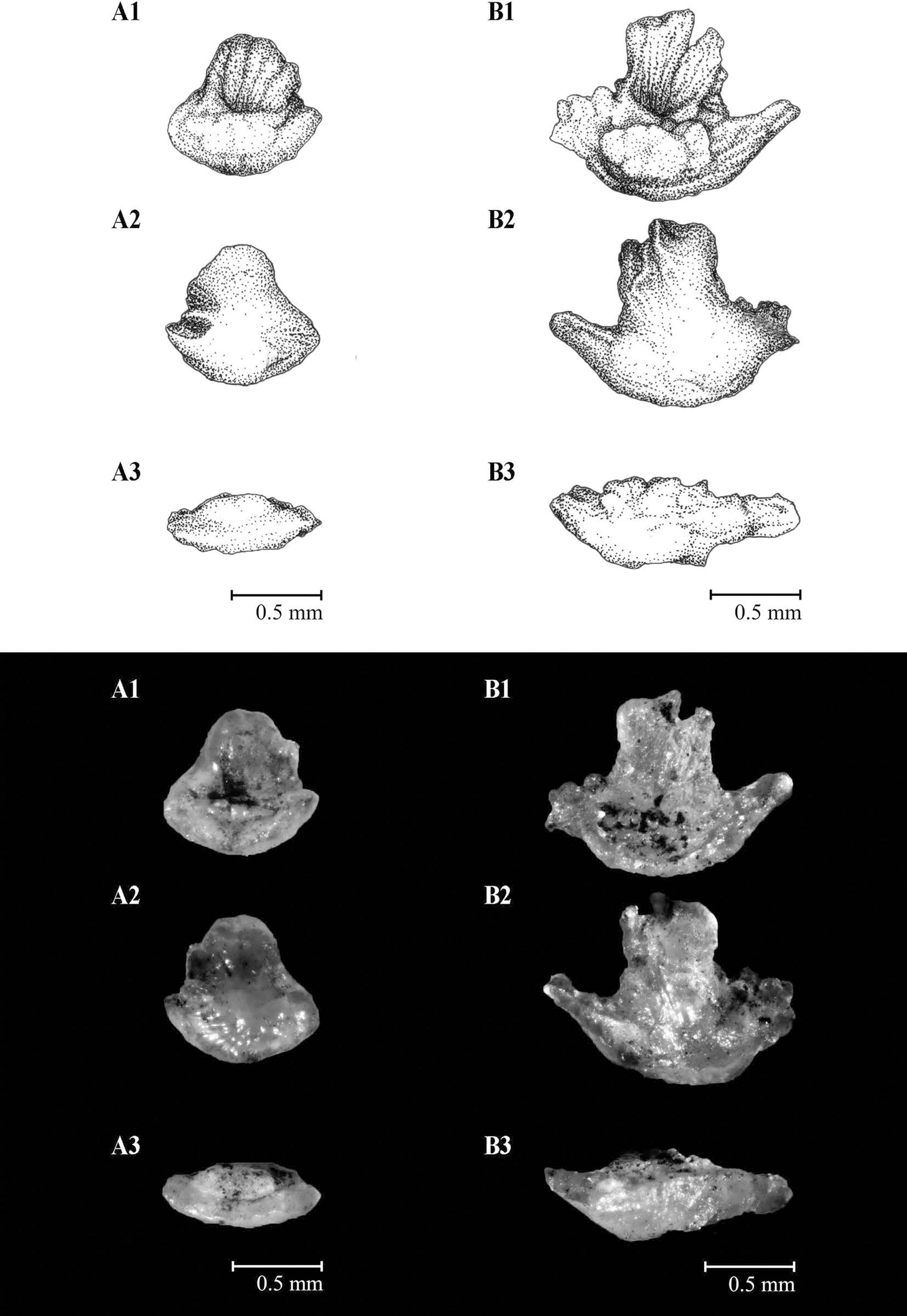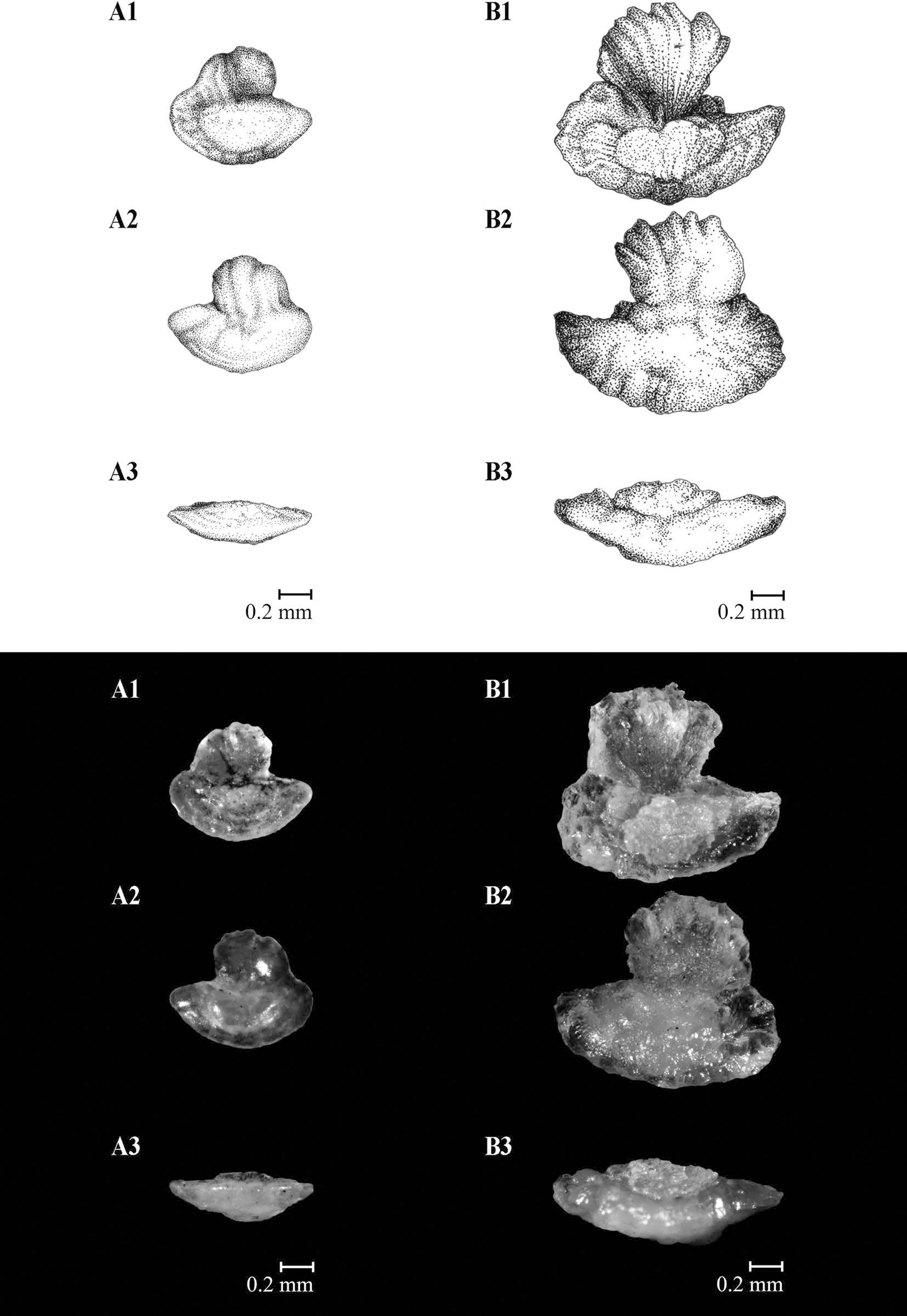Abstract
In addition to the series of documents that we have been publishing on the "Atlas of Teleostei Otoliths for the Southeastern-Southern Brazilian region", in this volume we present the results of species of the orders Atheriniformes (1 species), Beloniformes (5), Beryciformes (2), Zeiformes (2), Syngnathiformes (2), Scorpaeniformes (9) and Tetraodontiformes (6). Features, measurements and indices were analyzed according to methodology used in anterior series. Three otoliths of each species have been illustrated and photographed whenever possible. The frequency of occurrence of each characteristic was calculated by total length classes (TL), and differences within and among classes have been analyzed applying the multiple χ2 test (significance 0.05).
Descriptors:
Otoliths; Morphology; Morphometry; Southwestern Atlantic; Brazil
Resumo
Em adição à série de documentos que estamos publicando sobre o "Atlas de Otólitos para os peixes Teleósteos da região Sudeste-Sul do Brasil", neste volume apresentamos os resultados obtidos para espécies das ordens Atheriniformes (1 espécie), Beloniformes (5), Beryciformes (2), Zeiformes (2), Syngnathiformes (2), Scorpaeniformes (9) e Tetraodontiformes (6). Foram analisadas as feições, medidas e índices usualmente empregados conforme metodologia apresentada nas séries anteriores. Três otólitos de cada espécie foram desenhados e fotografados, sempre que possível. A frequência de ocorrência de cada característica por classe de comprimento total foi calculada (CT) e as diferenças dentro de cada classe e entre classes foram analisadas aplicando teste χ2 múltiplo (significância 0,05).
Descritores:
Otólitos; Morfologia; Morfometria; Atlântico Sudoeste; Brasil
INTRODUCTION
Otolith shape analyses are helpful indicators for community, population and individual analysis and environmental events.
Since 2014, as a contribution for these and other studies we have been improving the Collection of Teleostei Fish Otoliths of the Southeastern/Southern Brazilian region (COSS Brasil) held at the Instituto Oceanográfico USP, (IOUSP). Currently, the collection contains 51,886 pairs of otoliths from 66 families, 24 orders and 202 species (ROSSI-WONGTSCHOWSKI et al., 2016ROSSI-WONGTSCHOWSKI, C. L. D. B.; CHALOM, A.; SILIPRANDI, C. C.; BRENHA-NUNES, M. R.; CONVERSANI, V. R. M.; SANTIFICETUR, C.; GIARETTA, M.B. 2016. COSS-Brasil: Coleção de Otólitos de Peixes Marinhos da Região Sudeste-Sul do Brasil. Instituto Oceanográfico da Universidade de São Paulo. www.usp.br/cossbrasil (versão 2016).
www.usp.br/cossbrasil...
). Until now, we published results on the shape of other orders and many families in ROSSI-WONGTSCHOWSKI et al. (2014)ROSSI-WONGTSCHOWSKI, C. L. D. B.; SILIPRANDI, C. C.; BRENHA, M. R.; GONSALES, S. A.; SANTIFICETUR, C.; VAZ-DOS-SANTOS, A. M. Atlas of marine bony fish otoliths (Sagittae) of Southeastern - Southern Brazil Part I: Gadiformes (Macrouridae, Moridae, Bregmacerotidae, Phycidae and Merlucciidae); Part II: Perciformes (Carangidae, Sciaenidae, Scombridae and Serranidae). Braz. J. Oceanogr, v. 62, n. spe 1, p. 1-103, 2014., SILIPRANDI et al. (2016)SILIPRANDI, C. C.; BRENHA-NUNES, M. R.; ROSSI-WONGTSCHOWSKI, C. L. D. B.; SANTIFICETUR, C.; CONVERSANI, V. R. M. Atlas of marine bony fish otoliths (sagittae) of Southeastern-Southern Brazil Part III: Clupeiformes (Clupeidae, Engraulidae, Pristigasteridae). Braz. J. Oceanogr, 64, n. spe 1, p. 1-22, 2016. and BRENHA-NUNES et al. (2016)BRENHA-NUNES, M. R.; SANTIFICETUR, C.; CONVERSANI, V. R. M.; GIARETTA, M. B.; ROSSI-WONGTSCHOWSKI, C. L. D. B.; SILIPRANDI, C. C. Atlas of marine bony fish otoliths (sagittae) of Southeastern-Southern Brazil Part IV: Perciformes (Centropomidae, Acropomatidae, Serranidae, Priacanthidae, Malacanthidae, Pomatomidae, Carangidae, Lutjanidae, Gerreidae and Haemulidae). Braz. J. Oceanogr, v. 64, n. spe 1, p. 23-75, 2016.. These publications will constitute an Atlas of Otoliths of the Southeastern/Southern Brazilian region.
In this volume, we present results of the morphology and morphometry of the otoliths of species belonging to the orders Atheriniformes, Beloniformes, Beryciformes, Zeiformes, Syngnathiformes, Scorpaeniformes and Tetraodontiformes. We hope that our papers and our collection will contribute to all kinds of studies involving otolith morphology.
MATERIAL AND METHODS
The sampled area and the methodology of this study followed that presented in ROSSI-WONGTSCHOWSKI et al. (2014)ROSSI-WONGTSCHOWSKI, C. L. D. B.; SILIPRANDI, C. C.; BRENHA, M. R.; GONSALES, S. A.; SANTIFICETUR, C.; VAZ-DOS-SANTOS, A. M. Atlas of marine bony fish otoliths (Sagittae) of Southeastern - Southern Brazil Part I: Gadiformes (Macrouridae, Moridae, Bregmacerotidae, Phycidae and Merlucciidae); Part II: Perciformes (Carangidae, Sciaenidae, Scombridae and Serranidae). Braz. J. Oceanogr, v. 62, n. spe 1, p. 1-103, 2014., SILIPRANDI et al. (2016)SILIPRANDI, C. C.; BRENHA-NUNES, M. R.; ROSSI-WONGTSCHOWSKI, C. L. D. B.; SANTIFICETUR, C.; CONVERSANI, V. R. M. Atlas of marine bony fish otoliths (sagittae) of Southeastern-Southern Brazil Part III: Clupeiformes (Clupeidae, Engraulidae, Pristigasteridae). Braz. J. Oceanogr, 64, n. spe 1, p. 1-22, 2016. and BRENHA-NUNES et al. (2016)BRENHA-NUNES, M. R.; SANTIFICETUR, C.; CONVERSANI, V. R. M.; GIARETTA, M. B.; ROSSI-WONGTSCHOWSKI, C. L. D. B.; SILIPRANDI, C. C. Atlas of marine bony fish otoliths (sagittae) of Southeastern-Southern Brazil Part IV: Perciformes (Centropomidae, Acropomatidae, Serranidae, Priacanthidae, Malacanthidae, Pomatomidae, Carangidae, Lutjanidae, Gerreidae and Haemulidae). Braz. J. Oceanogr, v. 64, n. spe 1, p. 23-75, 2016..
The acronyms in the shape indices tables represent: TL=total fish length, OL=otolith length, OH=otolith height and OT=otolith thickness.
RESULTS
Order ATHERINIFORMES
Family ATHERINOPSIDAE
Illustrations (above) and photographs (below) of Atherinella brasiliensis otoliths from fish with total length: A. 32 mm; B. 86 mm; C. 141mm. The medial face is shown in A1; B1; C1; the lateral face in A2; B2; C2; and the ventral profile in A3; B3, C3 (Illustration: Laura Montserrat; Photos: Cesar Santificetur).
Shape: elliptic. Anterior region: peaked (45%), peaked-round, notched, angled-round. Posterior region: round (76%), angled, angled-round. Dorsal edge: lobed (47%), sinuate, entire, lobed to sinuate. Ventral edge: lobed (44%), sinuate (38%), lobed to entire, entire. Profile: concave-convex. Rostrum and antirostrum orientation: in agreement (85%), does not apply. Rostrum: developed (78%), underdeveloped. Antirostrum: underdeveloped (60%), developed, absent. Pseudorostrum: absent. Pseudoantirostrum: absent. Sulcus acusticus: position: supramedian (73%), median; orientation: ascending (76%), horizontal; opening: ostial; morphology: heterosulcoid; colliculum: heteromorphic; ostium: elliptic (62%), funnel-like; cauda: tubular sinuous.
Statistical differences (p<0.05) within some length classes were obtained for dorsal and ventral edges, anterior and posterior regions, rostrum and antirostrum development and orientation, sulcus acusticus orientation and position and ostium morphology. Along the fish growth statistical differences were found for dorsal and ventral edges, anterior and posterior regions, sulcus acusticus position and orientation, ostium morphology and rostrum development.
Order BELONIFORMES
Family HEMIRAMPHIDAE
The anterior region tends to be peaked, the sulcus acusticus orientation is ascending, the ostium is frequently elliptic and the cauda morphology is tubular slightly curved in most of otoliths. The pseudorostrum and pseudoantirostrum are always absent.
Illustrations (above) and photographs (below) of Hemiramphus brasiliensis otoliths from fish with total length: A. 116 mm; B. 200 mm. The medial face is shown in A1; B1; the lateral face in A2; B2; and the ventral profile in A3; B3 (Illustration: Sílvia de Almeida Gonsales; Photos: Cesar Santificetur).
Shape: elliptic to oval. Anterior region: peaked-round (92%), angled-round. Posterior region: oblique-round (54%), round, angled.Dorsal edge: lobed to sinuate (92%), dentate to lobed. Ventral edge: lobed (62%), lobed to sinuate, dentate to lobed. Profile: concave-convex. Rostrum and antirostrum orientation: does not apply. Rostrum: developed (85%), underdeveloped, absent. Antirostrum: absent. Sulcus acusticus: position: median; orientation: ascending; opening: pseudo-ostial; morphology: heterosulcoid; colliculum: heteromorphic; ostium: elliptic (62%), tubular; cauda: tubular slightly curved.
Statistical differences (p<0.05) within some length classes were obtained for dorsal edge, anterior region and rostrum development. No differences were found along the fish development.
Hyporhamphus roberti (Valenciennes 1847) - Plate 3
Illustrations (above) and photographs (below) of Hyporhamphus roberti otolith from fish with total length: A. 132 mm. The medial face is shown in A1; the lateral face in A2; and the ventral profile in A3 (Illustration: Sílvia de Almeida Gonsales; Photos: Cesar Santificetur).
Shape: elliptic.Anterior region: peaked.Posterior region: angled.Dorsal edge: sinuate.Ventral edge: entire.Profile: concave-convex.Rostrum and antirostrum orientation: does not apply. Rostrum: underdeveloped. Antirostrum: absent. Sulcus acusticus: position: median; orientation: ascending; opening: para-ostial; morphology: heterosulcoid; colliculum: heteromorphic; ostium: elliptic; cauda: tubular slightly curved.
Only one otolith was examined not allowing statistical analysis of the data but its morphometric characteristics are shown below:
Illustrations (above) and photographs (below) of Hyporhamphus unifasciatus otoliths from fish with total length: A. 116 mm; B. 190 mm; C. 261 mm. The medial face is shown in A1; B1; C1; the lateral face in A2; B2; C2; and the ventral profile in A3; B3; C3 (Illustration: Sílvia de Almeida Gonsales; Photos: Cesar Santificetur).
Shape: oval to elliptic (52%), elliptic (48%). Anterior region: peaked-round. Posterior region: oblique to angled (73%), oblique-round, oblique, round.Dorsal edge: lobed to sinuate (70%), crenate to entire, sinuate to entire, lobed. Ventral edge: lobed to sinuate (42%), sinuate to entire, lobed, crenate to entire. Profile: concave-convex. Rostrum and antirostrum orientation: does not apply (64%), in agreement.Rostrum: developed.Antirostrum: absent (64%), underdeveloped.Sulcus acusticus: position: median; orientation: ascending; opening: para-ostial (64%), pseudo-ostial; morphology: heterosulcoid; colliculum: heteromorphic; ostium: elliptic; cauda: tubular slightly curved (85%), tubular strongly curved.
Statistical differences (p<0.05) within some length classes were obtained for dorsal edge, posterior region and cauda morphology. No differences were found along the fish development.
Family BELONIDAE
The otolith shape is frequently rectangular, although Strongylura timucu tends to be elliptic to rectangular. The rostrum is always developed and the ostium is frequently funnel-like. The pseudorostrum and pseudoantirostrum are always absent.
Illustrations (above) and photographs (below) of Strongylura marina otoliths from fish with total length: A. 283 mm; B. 621 mm. The medial face is shown in A1; B1; the lateral face in A2; B2; and the ventral profile in A3; B3 (Illustration: Michelle Konig; Photos: Cesar Santificetur).
Shape: rectangular (80% - small fish), trapezoidal (large fish).Anterior region: double-peaked (80%), peaked.Posterior region: oblique-round (40%), flattened (40%), round.Dorsal edge: crenate to lobed (40%), lobed to sinuate (40%), crenate to entire. Ventral edge: lobed (60%), dentate to lobed. Profile: plane-convex (80%), concave-convex. Rostrum and antirostrum orientation: in agreement (80%), does not apply. Rostrum: developed. Antirostrum: developed (80%), absent. Sulcus acusticus: position: median (80%), supramedian; orientation: ascending; opening: ostial; morphology: heterosulcoid; colliculum: heteromorphic; ostium: funnel-like (80%), elliptic; cauda: tubular straight.
The small number of otoliths examined did not permit the statistical analysis of the data but its morphometric characteristics are shown below:
Illustrations (above) and photographs (below) of Strongylura timucu right otolith from fish with total length: A. 156 mm. The medial face is shown in A1; the lateral face in A2; and the ventral profile in A3 (Illustration: Michelle Konig; Photos: Cesar Santificetur).
Shape: elliptic to rectangular (67%), elliptic.Anterior region: peaked.Posterior region: round. Dorsal edge: entire. Ventral edge: sinuate to entire. Profile: flattened. Rostrum and antirostrum orientation: in agreement.Rostrum: developed.Antirostrum: underdeveloped. Sulcus acusticus: position: median; orientation: horizontal; opening: ostial; morphology: heterosulcoid; colliculum: heteromorphic; ostium: funnel-like; cauda: tubular slightly curved.
The small number of otoliths examined did not permit the statistical analysis of the data but its morphometric characteristics are shown below:
Order BERYCIFORMES
Family BERYCIDAE
Illustrations (above) and photographs (below) of Beryx splendens right otoliths from fish with total length: A. 170 mm; B. 314 mm. The medial face is shown in A1; B1; the lateral face in A2; B2; and the ventral profile in A3; B3 (Illustration: Laura Montserrat; Photos: Cesar Santificetur).
Shape: trapezoidal.Anterior region: oblique (90%), oblique to peaked.Posterior region: peaked-round (76%), peaked, oblique-round, oblique. Dorsal edge: lobed (83%), sinuate. Anterior ventral edge: lobed (90%), entire, sinuate.Posterior ventral edge: lobed (79%), sinuate. Central ventral edge: lobed. Profile: concave-convex (86%), flattened. Rostrum and antirostrum orientation: does not apply (86%), in agreement.Rostrum: developed (86%), underdeveloped. Antirostrum: absent (86%), underdeveloped. Pseudorostrum: absent. Pseudoantirostrum: absent.Sulcus acusticus: position: supramedian; orientation: ascending (93%), horizontal; opening: ostio-caudal (66%), ostial; morphology: heterosulcoid; colliculum: heteromorphic; ostium: bent-concave (93%), tubular; cauda: tubular straight.
Statistical differences (p<0.05) within some length classes were obtained for dorsal, ventral and posterior ventral edges, anterior and posterior regions, rostrum and antirostrum development and orientation, sulcus acusticus opening and orientation, ostium morphology and profile. No differences were found along the fish development.
Family TRACHICHTHYIDAE
Illustrations (above) and photographs (below) of Hoplostethus occidentalis right otoliths from fish with total length: A. 93 mm; B. 169 mm; C. 245 mm. The medial face is shown in A1; B1; C1; the lateral face in A2; B2; C2; and the ventral profile in A3; B3; C3 (Illustration: Laura Montserrat; Photos: Cesar Santificetur).
Shape: trapezoidal to irregular.Anterior region: oblique (86%), oblique to peaked, flattened. Posterior region: oblique to angled (82%), oblique, oblique to peaked, flattened to irregular. Dorsal edge: lobed (42%), sinuate (33%), lobed to sinuate, dentate to lobed. Anterior ventral edge: entire (47%), sinuate (47%), lobed.Posterior ventral edge: entire (58%), sinuate, lobed. Central ventral edge: sinuate (81%), entire. Profile: plane-convex. Rostrum and antirostrum orientation: in agreement.Rostrum: developed.Antirostrum: underdeveloped (72%), developed. Pseudorostrum: absent. Pseudoantirostrum: absent. Sulcus acusticus: position: median; orientation: horizontal; opening: ostial; morphology: heterosulcoid; colliculum: heteromorphic; ostium: discoidal; cauda: elliptic.
Statistical differences (p<0.05) within some length classes were obtained for dorsal, anterior ventral, posterior ventral and central ventral edges and anterior and posterior regions. Along the fish growth statistical differences were found for dorsal and ventral edges.
Order ZEIFORMES
Family GRAMMICOLEPIDIDAE
Illustrations (above) and photographs (below) of Xenolepidichthys dalgleishi otoliths from fish with total length: A. 68 mm; B. 127 mm; C. 260 mm. The medial face is shown in A1; B1; C1; the lateral face in A2; B2; C2; and the ventral profile in A3; B3; C3 (Illustration: Laura Montserrat; Photos: Cesar Santificetur).
Shape: hour-glass.Anterior region: double-peaked.Posterior region: double-peaked.Dorsal edge: lobed (61%), sinuate, lobed to sinuate.Ventral edge: sinuate (32%), lobed to sinuate (24%), lobed (24%), sinuate to entire. Profile: concave-convex. Rostrum and antirostrum orientation: in agreement.Rostrum: developed.Antirostrum: developed.Pseudorostrum: developed.Pseudoantirostrum: developed.Sulcus acusticus: position: median; orientation: horizontal; opening: ostio-caudal; morphology: homosulcoid; colliculum: homomorphic; ostium: funnel-like; cauda: funnel-like.
Statistical differences (p<0.05) within some length classes were obtained for dorsal and ventral edges. Along the fish’s growth statistical differences were found for dorsal and ventral edges.
Family ZENIONTIDAE
Illustrations (above) and photographs (below) of Zenion hololepis otoliths from fish with total length: A. 56 mm; B. 114 mm; C. 173 mm. The medial face is shown in A1; B1; C1; the lateral face in A2; B2; C2; and the ventral profile in A3; B3; C3 (Illustration: Laura Montserrat; Photos: Cesar Santificetur).
Shape: bullet-shaped (48%), elliptic (37%), discoidal, rectangular.Anterior region: round (59%), angled-round, oblique. Posterior region: flattened (59%), round, oblique. Dorsal edge: lobed to sinuate (37%), lobed (37%), sinuate to entire, dentate to sinuate.Ventral edge: entire (96%), lobed, presenting an anterior and posterior projections.Profile: plane-convex.Rostrum and antirostrum orientation: does not apply. Rostrum: absent. Antirostrum: absent. Pseudorostrum: absent. Pseudoantirostrum: absent.Sulcus acusticus: position: median; orientation: ascending (70%), horizontal; opening: mesial; morphology: pseudo-archaesulcoid; colliculum: homomorphic; ostium: round-oval; cauda: round-oval.
Statistical differences (p<0.05) within some length classes were obtained for shape, ventral edge, anterior and posterior regions and sulcus acusticus orientation. Along the fish growth statistical differences were found only for anterior region.
Order SYNGNATHIFORMES
Family CENTRISCIDAE
The otoliths of this family is clearly hour-glass, the pseudorostrum is always developed and pseudoantirostrum is frequently underdeveloped. The sulcus acusticus position is supramedial, the opening is ostio-caudal, morphology is homosulcoid, colliculum is homomorphic and ostium and cauda are always funnel-like.
Illustrations (above) and photographs (below) of Macroramphosus scolopax otolith from fish with total length: A. 107 mm. The medial face is shown in A1; the lateral face in A2; and the ventral profile in A3 (Illustration: Alexandre Arackawa; Photos: Cesar Santificetur).
Shape: hour-glass.Anterior region: blunt.Posterior region: blunt.Dorsal edge: entire. Ventral edge: sinuate to entire.Profile: concave-convex.Rostrum and antirostrum orientation: in agreement.Rostrum: developed.Antirostrum: underdeveloped. Pseudorostrum: developed.Pseudoantirostrum: underdeveloped.Sulcus acusticus: position: supramedian; orientation: horizontal; opening: ostio-caudal; morphology: homosulcoid; colliculum: homomorphic; ostium: funnel-like; cauda: funnel-like.
The small number of otoliths examined did not permit the statistical analysis of the data but its morphometric characteristics are shown below:
Illustrations (above) and photographs (below) of Notopogon fernandezianus otolith from fish with total length: A. 161 mm. The medial face is shown in A1; the lateral face in A2; and the ventral profile in A3 (Illustration: Alexandre Arackawa; Photos: Cesar Santificetur).
Shape: hour-glass.Anterior region: notched (83%), blunt.Posterior region: notched (67%), blunt. Dorsal edge: entire. Ventral edge: sinuate (50%), lobed to sinuate (50%). Profile: concave-convex.Rostrum and antirostrum orientation: in agreement.Rostrum: developed. Antirostrum: underdeveloped. Pseudorostrum: developed. Pseudoantirostrum: underdeveloped (83%), absent. Sulcus acusticus: position: supramedian; orientation: horizontal; opening: ostio-caudal; morphology: homosulcoid; colliculum: homomorphic; ostium: funnel-like; cauda: funnel-like.
The small number of otoliths examined did not permit the statistical analysis of the data but its morphometric characteristics are shown below:
Order SCORPAENIFORMES
Family TRIGLIDAE
The otolith shape is frequently elliptic and pseudorostrum and pseudoantirostrum are always absent. The analyzed species present some variation in the sulcus acusticus opening which differs from other families.
Illustrations (above) and photographs (below) of Bellator brachychir otoliths from fish with total length: A. 34 mm; B. 95 mm. The medial face is shown in A1; B1; the lateral face in A2; B2; and the ventral profile in A3; B3 (Illustration: Laura Montserrat; Photos: Cesar Santificetur).
Shape: elliptic (89%), triangular to elliptic. Anterior region: blunt to peaked (32%), peaked-round (26%), angled-round (21%), peaked. Posterior region: flattened (32%), peaked-round (21%), round (21%), peaked. Anterior dorsal edge: entire (89%), sinuate. Posterior dorsal edge: does not apply (89%), entire.Ventral edge: entire (53%), sinuate (47%). Profile: plane-convex. Rostrum and antirostrum orientation: does not apply (95%), in agreement. Rostrum: developed. Antirostrum: absent (95%), underdeveloped. Sulcus acusticus: position: median; orientation: horizontal; opening: ostial (89%), pseudo-ostial; morphology: heterosulcoid; colliculum: heteromorphic; ostium: elliptic (74%), funnel-like; cauda: round-oval.
Statistical differences (p<0.05) within some length classes were obtained for shape, anterior dorsal, posterior dorsal and ventral edges, anterior region, sulcus acusticus opening, antirostrum development, rostrum and antirostrum orientation and ostium morphology. Along the fish growth statistical differences were found for ventral edge, anterior and posterior regions.
Illustrations (above) and photographs (below) of Prionotus nudigula otoliths from fish with total lengths: A. 68 mm; B. 162 mm; C. 265 mm. The medial face is shown in A1, B1, C1; the lateral face in A2, B2, C2; and the ventral profile in A3, B3, C3 (Illustration: Laura Montserrat; Photos: Cesar Santificetur).
Shape: elliptic.Anterior region: angled-round (82%), peaked, peaked-round, round.Posterior region: angled-round (77%), peaked, round, peaked-round.Dorsal edge: sinuate (57%), entire, lobed to sinuate, sinuate to entire. Ventral edge: sinuate (71%), lobed to sinuate, entire, sinuate to entire. Profile: concave-convex. Rostrum and antirostrum orientation: in agreement (75%), does not apply.Rostrum: developed (87%), underdeveloped. Antirostrum: underdeveloped (74%), absent, developed. Sulcus acusticus: position: median; orientation: horizontal; opening: ostial (78%), para-ostial, pseudo-ostial, ostio-caudal; morphology: heterosulcoid; colliculum: heteromorphic; ostium: funnel-like (56%), elliptic; cauda: tubular markedly curved (64%), tubular strongly curved, round-oval, elliptic.
Significant differences (p<0.05) were obtained within some length classes for dorsal and ventral edges, anterior and posterior regions, sulcus acusticus opening and position, ostium and cauda morphology and rostrum and antirostrum development and orientation. Along the fish development statistical differences were found for dorsal and ventral edges, cauda morphology, rostrum and antirostrum development and orientation.
Illustrations (above) and photographs (below) of Prionotus punctatus otoliths from fish with total lengths: A. 36 mm; B. 184 mm; C. 391 mm. The medial face is shown in A1, B1, C1; the lateral face in A2, B2, C2; and the ventral profile in A3, B3, C3 (Illustration: Laura Montserrat;
Shape: elliptic.Anterior region: peaked (73%), angled-round, peaked-round.Posterior region: round (51%), angled-round, peaked, flattened.Dorsal edge: lobed to sinuate (44%), dentate to lobed, lobed, sinuate to entire. Ventral edge: lobed to sinuate (34%), lobed (31%), dentate to lobed (27%), sinuate to entire. Profile: concave-convex. Rostrum and antirostrum orientation: does not apply (97%), in agreement.Rostrum: developed.Antirostrum: absent (97%), underdeveloped.Sulcus acusticus: position: median; orientation: horizontal; opening: pseudo-ostial (71%), ostial; morphology: heterosulcoid; colliculum: heteromorphic; ostium: elliptic (53%), tubular, funnel-like; cauda: tubular strongly curved (71%), tubular markedly curved.
Significant differences (p<0.05) were obtained within some length classes for dorsal and ventral edges, anterior and posterior regions, sulcus acusticus opening, ostium and cauda morphology, antirostrum development and rostrum and antirostrum orientation. Along the fish development statistical differences were found only for the ostium morphology.
Family DACTYLOPTERIDAE
Illustrations (above) and photographs (below) of Dactylopterus volitans otoliths from fish with total lengths: A. 65 mm; B. 192 mm; C. 272 mm. The medial face is shown in A1, B1, C1; the lateral face in A2, B2, C2; and the ventral profile in A3, B3, C3 (Illustration: Laura Montserrat; Photos: Cesar Santificetur).
Shape: oval (80%), discoidal, elliptic, hour-glass.Anterior region: double-peaked (62%), peaked-round, blunt, angled. Posterior region: oblique-round (50%), round (44%), blunt, flattened. Dorsal edge: entire (94%), sinuate, lobed, crenate. Ventral edge: entire (42%), sinuate, crenate, lobed. Profile: plane-convex. Rostrum and antirostrum orientation: in agreement. Rostrum: developed (67%), underdeveloped. Antirostrum: underdeveloped (51%), developed (49%). Pseudorostrum: absent (98%), underdeveloped, developed. Pseudoantirostrum: absent (98%), underdeveloped, developed.Sulcus acusticus: position: median; orientation: horizontal; opening: ostial (95%), ostio-caudal; morphology: heterosulcoid; colliculum: heteromorphic; ostium: funnel-like; cauda: tubular markedly curved (90%), tubular strongly curved, round-oval.
Significant differences (p<0.05) were obtained within some length classes for shape, dorsal and ventral edges, anterior and posterior regions, sulcus acusticus opening, cauda morphology and rostrum, antirostrum, pseudorostrum and pseudoantirostrum development. Along the otoliths growth statistical differences were found for ventral edge, anterior and posterior regions and rostrum and antirostrum development.
Family SEBASTIDAE
Illustrations (above) and photographs (below) of Helicolenus lahillei otoliths from fish with total lengths: A. 75 mm; B. 260 mm; C. 462 mm. The medial face is shown in A1, B1, C1; the lateral face in A2, B2, C2; and the ventral profile in A3, B3, C3 (Illustration: Laura Montserrat; Photos: Cesar Santificetur).
Shape: elliptic (79%), fusiform, elliptic to lanceolated, fusiform to lanceolated.Anterior region: peaked (91%), lanceolated.Posterior region: round (32%), oblique-round (26%), flattened, peaked. Dorsal edge: entire (45%), sinuate (41%), lobed, lobed to sinuate. Ventral edge: sinuate (39%), lobed to sinuate (35%), serrate to entire, entire.Profile: concave-convex. Rostrum and antirostrum orientation: in agreement (60%), does not apply. Rostrum: developed (98%), absent.Antirostrum: underdeveloped (60%), absent. Pseudorostrum: absent.Pseudoantirostrum: absent.Sulcus acusticus: position: inframedian (67%), median; orientation: horizontal; opening: ostial (93%), para-ostial, pseudo-ostial; morphology: heterosulcoid; colliculum: heteromorphic; ostium: funnel-like (90%), elliptic; cauda: tubular straight (52%), tubular slightly curved (48%).
Significant differences (p<0.05) were obtained within some length classes for shape, dorsal and ventral edges, anterior and posterior regions, sulcus acusticus opening and position, ostium and cauda morphology and rostrum development. Along the fish development statistical differences were found for dorsal and ventral edges, posterior region, sulcus acusticus position and cauda morphology.
Family PERISTEDIIDAE
Illustrations (above) and photographs (below) of Peristedion altipinne otolith from fish with total lengths: A. 124 mm; B. 258 mm. The medial face is shown in A1, B1; the lateral face in A2, B2; and the ventral profile in A3, B3 (Illustration: Laura Montserrat; Photos: Cesar Santificetur).
Shape: elliptic (56%), oval.Anterior region: double-peaked (33%), peaked, blunt, round.Posterior region: round (35%), angled-round (33%), angled, oblique.Dorsal edge: sinuate (76%), entire, lobed to sinuate. Ventral edge: sinuate (82%), entire, lobed to sinuate. Profile: concave-convex.Rostrum and antirostrum orientation: in agreement (69%), does not apply. Rostrum: underdeveloped (65%), developed, absent. Antirostrum: underdeveloped (56%), absent, developed. Pseudorostrum: absent. Pseudoantirostrum: absent (98%), underdeveloped. Sulcus acusticus: position: median (69%), inframedian; orientation: horizontal; opening: ostial (85%), pseudo-ostial, para-ostial, ostio-caudal morphology: heterosulcoid; colliculum: heteromorphic; ostium: elliptic (95%), funnel-like; cauda: tubular straight (93%), tubular strongly curved, tubular slightly curved.
Significant differences (p<0.05) were obtained within some length classes for shape, dorsal and ventral edges, anterior and posterior regions, sulcus acusticus opening and position, ostium and cauda morphology and rostrum and pseudoantirostrum development. Along the otolith growth statistical differences were found for shape, anterior region and sulcus acusticus position.
Family SCORPAENIDAE
The two species of this family are very different from each other and presented no common features. The pseudorostrum and pseudoantirostrum are always absent.
Illustrations (above) and photographs (below) of Pontinus rathbuni otolith from fish with total length: A. 97 mm. The medial face is shown in A1; the lateral face in A2; and the ventral profile in A3 (Illustration: Vanessa Sugihara; Photos: Cesar Santificetur).
Shape: elliptic.Anterior region: peaked-round.Posterior region: peaked.Dorsal edge: entire. Ventral edge: sinuate to entire. Profile: plane-convex. Rostrum and antirostrum orientation: in agreement.Rostrum: developed.Antirostrum: underdeveloped.Sulcus acusticus: position: median; orientation: horizontal; opening: para-ostial; morphology: heterosulcoid; colliculum: heteromorphic; ostium: elliptic; cauda: tubular strongly curved.
The small number of otoliths examined did not allow the statistical analysis of the data but its morphometric characteristics are shown below:
Illustrations (above) and photographs (below) of Scorpaena dispar right otoliths from fish with total lengths: A. 38 mm; B. 129 mm. The medial face is shown in A1, B1; the lateral face in A2, B2; and the ventral profile in A3, B3 (Illustration: Vanessa Sugihara; Photos: Cesar Santificetur).
Shape: elliptic.Anterior region: peaked.Posterior region: round (50%), peaked (50%). Dorsal edge: sinuate to entire.Ventral edge: entire (50%), sinuate to entire (50%).Profile: concave-convex (50%), biconvex (50%). Rostrum and antirostrum orientation: does not apply. Rostrum: developed. Antirostrum: absent. Sulcus acusticus: position: median; orientation; horizontal; opening: ostial; morphology: heterosulcoid; colliculum: heteromorphic; ostium: elliptic; cauda: tubular slightly curved (50%), round-oval (50%).
The small number of otoliths examined did not permit the statistical analysis of the data but its morphometric characteristics are shown below:
Family SETARCHIDAE
Illustrations (above) and photographs (below) of Setarches guentheri otoliths from fish with total lengths: A. 43 mm; B. 148 mm; C. 254 mm. The medial face is shown in A1, B1, C1; the lateral face in A2, B2, C2; and the ventral profile in A3, B3, C3 (Illustration: Laura Montserrat; Photos: Cesar Santificetur).
Shape: elliptic (65%), elliptic to lanceolated, fusiform to lanceolated, elliptic to cuneiform. Anterior region: peaked (50%), lanceolated-round, peaked-round, lanceolated. Posterior region: round (74%), angled-round, flattened, double-peaked.Dorsal edge: lobed (36%), lobed to sinuate (34%), sinuate (27%), entire. Ventral edge: sinuate (55%), entire, lobed to sinuate, sinuate to entire. Profile: flattened (64%), plane-convex. Rostrum and antirostrum orientation: in agreement (84%), does not apply.Rostrum: developed.Antirostrum: underdeveloped (67%), developed, absent.Pseudorostrum: absent (99%), underdeveloped. Pseudoantirostrum: absent (99%), underdeveloped. Sulcus acusticus: position: median; orientation: horizontal; opening: ostial (99%), ostio-caudal; morphology: pseudo-archaesulcoid; colliculum: heteromorphic; ostium: funnel-like; cauda: elliptic.
Significant differences (p<0.05) were obtained within some length classes for shape, profile, dorsal and ventral edges, anterior and posterior regions, sulcus acusticus opening, ostium and cauda morphology, antirostrum, pseudorostrum and pseudoantirostrum development and rostrum and antirostrum orientation. Along the fish development statistical differences were found for shape, profile, dorsal and ventral edges and anterior region.
Order TETRAODONTIFORMES
Family DIODONTIDAE
Illustrations (above) and photographs (below) of Chilomycterus spinosus otolith from fish with total length: A. 52 mm. The medial face is shown in A1; the lateral face in A2; and the ventral profile in A3 (Illustration: Alexandre Arackawa; Photos: Cesar Santificetur).
Shape: discoidal (58%), tall, irregular.Anterior region: round (69%), double-peaked, notched, flattened. Posterior region: round. Dorsal edge: entire (62%), sinuate. Ventral edge: entire (62%), sinuate. Profile: plane-convex. Rostrum and antirostrum orientation: does not apply (92%), in agreement. Rostrum: absent. Antirostrum: absent (92%), underdeveloped. Pseudorostrum: absent. Pseudoantirostrum: absent. Sulcus acusticus: position: inframedian; orientation: horizontal; opening: ostio-caudal (92%), ostial; morphology: pseudo-archaesulcoid; colliculum: monomorphic; ostium: tubular (54%), funnel-like (46%); cauda: tubular markedly curved (62%), tubular straight.
Significant differences (p<0.05) were obtained within some length classes for shape, dorsal and ventral edges, anterior region, sulcus acusticus opening, antirostrum development and rostrum and antirostrum orientation. Along the otolith growth statistical differences were found for dorsal and ventral edges.
Illustrations (above) and photographs (below) of Diodon holocanthus otolith from fish with total length: A. 111 mm. The medial face is shown in A1; the lateral face in A2; and the ventral profile in A3 (Illustration: Alexandre Arackawa; Photos: Cesar Santificetur).
Shape: tall.Anterior region: peaked.Posterior region: round.Dorsal edge: sinuate (50%), lobed (50%). Ventral edge: sinuate (50%), entire (50%). Profile: concave-convex. Rostrum and antirostrum orientation: in agreement.Rostrum: developed.Antirostrum: underdeveloped. Pseudorostrum: absent. Pseudoantirostrum: absent. Pseudorostrum: absent. Pseudoantirostrum: absent. Sulcus acusticus: position: supramedian; orientation: horizontal (50%), descending (50%); opening: ostial; morphology: heterosulcoid; colliculum: heteromorphic; ostium: funnel-like; cauda round-oval.
The small number of otoliths examined did not allow the statistical analysis of the data but its morphometric characteristics are shown below:
Family TETRAODONTIDAE
The otolith of this family is clearly hour-glass the sulcus acusticus position is medial, the orientation is horizontal, morphology is homosulcoid, colliculum is homomorphic and ostium and cauda are always funnel-like.
Illustrations (above) and photographs (below) of Lagocephalus laevigatus right otolith from fish with total length: A. 144 mm. The medial face is shown in A1; the lateral face in A2; and the ventral profile in A3 (Illustration: Alexandre Arackawa; Photos: Cesar Santificetur).
Shape: hour-glass. Anterior region: notched. Posterior region: notched. Dorsal edge: lobed to sinuate. Ventral edge: lobed to sinuate. Profile: concaveconvex. Rostrum and antirostrum orientation: in agreement. Rostrum: developed.Antirostrum: developed. Pseudorostrum: underdeveloped.Pseudoantirostrum: underdeveloped.Sulcus acusticus: position: median; orientation: horizontal; opening: ostio-caudal; morphology: homosulcoid; colliculum: homomorphic; ostium: funnel-like; cauda: funnel-like.
The small number of otoliths examined did not permit the statistical analysis of the data but it morphometric characteristics are shown below:
Illustrations (above) and photographs (below) of Sphoeroides greeleyi otoliths from fish with total lengths: A. 78 mm; B. 145 mm. The medial face is shown in A1, B1; the lateral face in A2, B2; and the ventral profile in A3, B3 (Illustration: Alexandre Arackawa; Photos: Cesar Santificetur).
Shape: hour-glass (87%), trapezoidal to elliptic.Anterior region: double-peaked-round (52%), double-peaked (43%), angled-round. Posterior region: double-peaked-round (61%), oblique to angled, oblique-round. Dorsal edge: entire (61%), lobed. Ventral edge: entire (61%), sinuate to entire. Profile: planeconvex. Rostrum and antirostrum orientation: in agreement. Rostrum: developed (96%), underdeveloped. Antirostrum: underdeveloped (74%), developed. Pseudorostrum: developed (74%), underdeveloped, absent. Pseudoantirostrum: underdeveloped (74%), absent.Sulcus acusticus: position: median; orientation: horizontal; opening: ostio-caudal; morphology: homosulcoid; colliculum: homomorphic; ostium: funnel-like; cauda: funnel-like.
Significant differences (p<0.05) were obtained within some length classes for shape, dorsal and ventral edges, anterior and posterior regions and rostrum, antirostrum, pseudorostrum and pseudoantirostrum development. Along the fish’s development statistical differences were found for dorsal and ventral edges, anterior and posterior regions and pseudoantirostrum development.
Illustrations (above) and photographs (below) of Sphoeroides testudineus otoliths from fish with total lengths: A. 94 mm; B. 212 mm. The medial face is shown in A1, B1; the lateral face in A2, B2; and the ventral profile in A3, B3 (Illustration: Alexandre Arackawa; Photos: Cesar Santificetur).
Shape: hour-glass.Anterior region: blunt to peaked (50%), double-peaked (50%).Posterior region: blunt-round.Dorsal edge: sinuate to entire.Ventral edge: entire (50%), sinuate to entire (50%). Profile: plane-convex. Rostrum and antirostrum orientation: in agreement. Rostrum: developed. Antirostrum: underdeveloped (50%), developed (50%). Pseudorostrum: underdeveloped.Pseudoantirostrum: underdeveloped.Sulcus acusticus: position: median; orientation: horizontal; opening: ostio-caudal; morphology: homosulcoid; colliculum: homomorphic; ostium: funnel-like; cauda: funnel-like.
The small number of otoliths examined did not allow the statistical analysis of the data but its morphometric characteristics are shown below:
Family MONACANTHIDAE
Illustrations (above) and photographs (below) of Stephanolepis hispidus otoliths from fish with total lengths: A. 37 mm; B. 195 mm. The medial face is shown in A1, B1; the lateral face in A2, B2; and the ventral profile in A3, B3 (Illustration: Alexandre Arackawa; Photos: Cesar Santificetur).
Shape: hour-glass. Anterior region: notched (75%), blunt to angled. Posterior region: notched (50%), blunt (50%). Dorsal edge: entire. Ventral edge: entire. Profile: plane-convex. Rostrum and antirostrum orientation: in agreement. Rostrum: underdeveloped (75%), developed. Antirostrum: underdeveloped (75%), developed. Pseudorostrum: underdeveloped (75%), developed. Pseudoantirostrum: underdeveloped (75%), developed. Sulcus acusticus: position: median; orientation: horizontal; opening: ostio-caudal; morphology: homosulcoid; colliculum: homomorphic; ostium: funnel-like; cauda: funnel-like.
The small number of otoliths examined did not permit the statistical analysis of the data but its morphometric characteristics are shown below:
ACKNOWLEDGMENTS
Many thanks to Thiago José Balbi for some otoliths measurements and to Alexandre Arackawa, Sílvia Gonsales, Laura Montserrat, Michelle Konig and Vanessa Sugihara for the otoliths drawings. Also special thanks to Dr. Carlos Assis for their valuable comments that improved a lot this paper. This paper received substantial financial support from the Fundação de Amparo à Pesquisa do Estado de São Paulo (FAPESP Process Numbers: 2010/51631 2 and 2014/03764 4).
REFERENCES
- ALMEIDA-SILVA, P. H.; TUBINO, R. A.; ZAMBRANO, L. C.; HUNDER, D. A.; GARRITANO, S. R.; MONTEIRO-NETO, C. Trophic ecology and food consumption of fishes in a hypersaline tropical lagoon. J. Fish Biol., v. 86, n. 6, p. 1781-1795, 2015.
- BERNARDES, R. A.; FIGUEIREDO, J. L.; RODRIGUES, A. R.; FISCHER, L. G.; VOOREN, C. M.; HAIMOVICI, M.; ROSSI-WONGTSCHOWSKI, C. L. D. B. Peixes da Zona Exclusiva da região Sudeste-Sul do Brasil: levantamento com armadilhas, pargueiras e rede de arrasto de fundo São Paulo: EDUSP, 2005. p. 304.
- BRENHA-NUNES, M. R.; SANTIFICETUR, C.; CONVERSANI, V. R. M.; GIARETTA, M. B.; ROSSI-WONGTSCHOWSKI, C. L. D. B.; SILIPRANDI, C. C. Atlas of marine bony fish otoliths (sagittae) of Southeastern-Southern Brazil Part IV: Perciformes (Centropomidae, Acropomatidae, Serranidae, Priacanthidae, Malacanthidae, Pomatomidae, Carangidae, Lutjanidae, Gerreidae and Haemulidae). Braz. J. Oceanogr, v. 64, n. spe 1, p. 23-75, 2016.
- CARPENTER, K. E.; MUNROE, T. Atherinella brasiliensis. The IUCN Red List of Threatened Species 2015: e.T16411567A16510327, 2015 Cambridge: IUCN Global Species Programme Red List Unit, 2015.
- CARVALHO-FILHO, A. Peixes da Costa Brasileira 2a ed. São Paulo: Marca D’Água, 1992. 304 p.
- CERVIGÓN, F.; CIPRIANI, R.; FISCHER, L. W.; GARIBALDI, L.; HENDRICKX, M.; LEMUS, A. J.; MÁRQUEZ, R.; POUTIERS, J. M.; ROBAINA, G.; RODRIQUEZ, B. Fichas FAO de identificación de especies para los fines de la pesca: guía de campo de las especies comerciales marinas y de aquas salobres de la costa septentrional de Sur América Rome: FAO, 1992. p. 513.
- CHERNOFF, B. Atherinopsidae - New World silversides. In: CARPENTER, K. E.; NIEM, V. H. (Eds.). The Living Marine Resources of the Western Central Atlantic Vol. 2. Bony fishes part 1 (Acipenseridae to Grammatidae). Rome: FAO, 2002. p. 1086-1103.
- CHI-ESPÍNOLA, A. A.; VEGA-CENDEJAS, M. E. Feeding habits of Sphoeroides testudineus (Perciformes: Tetraodontidae) in the lagoon system of Ria Lagartos, Yucatán, Mexico. Rev. Biol. Trop., v. 61, n. 2, p. 849-858, 2013.
- COLLETTE, B. B. Hemiramphidae. In: CARPENTER, K. E.; NIEM, V. H. (Eds.). The Living Marine Resources of the Western Central Atlantic Vol. 2. Bony fishes part 1 (Acipenseridae to Grammatidae). Rome: FAO, 2002a. p. 1116-1144.
- COLLETTE, B. B. Belonidae. In: CARPENTER, K. E.; NIEM, V. H. (Eds.). The Living Marine Resources of the Western Central Atlantic Vol. 2. Bony fishes part 1 (Acipenseridae to Grammatidae). Rome: FAO, 2002b. p. 1104-1103.
- CONTENTE, R. F.; STEFANONI, M. F.; SPACH, H. L. Feeding ecology of the Brazilian silverside Atherinella brasiliensis (Atherinopsidae) in a sub-tropical estuarine ecosystem. J. Mar. Biol. Assoc. U.K., v. 91, n. 6, p. 1197-1205, 2011.
- DENADAI, M. R.; SANTOS, F. B.; BESSA, E.; BERNARDES, L. P.; TURRA, A. Population biology and diet of the puffer fish Lagocephalus laevigatus (Tetraodontiformes: Tetraodontidae) in Caraguatatuba Bay, south-eastern Brazil. J. Mar. Biol. Assoc. U.K., v. 92, n. 2, p. 407-412, 2012.
- EHRICH, S. Macroramphosidae. In: WHITEHEAD, P. J. P.; BAUCHOT, M. L.; HUREAU, J. C.; NIELSEN, J.; TORTONESE, E. (Eds.). Fishes of the North-Eastern Atlantic and the Mediterranean Vol. 2. Paris: UNESCO, 1986. 627 p.
- EHRICH, S. Macroramphosidae. In: QUERO, J. C.; HUREAU, J. C.; KARRER, C.; POST, A.; SALDANHA, L. (Eds.). Check-list of the fishes of the eastern tropical Atlantic (CLOFETA) Vol. 2. JNICT, Lisbon; SEI, Paris and UNESCO. Paris: UNESCO, 1990. p. 656-657.
- FIGUEIREDO, J. L.; MENEZES, N. A. Manual de peixes marinhos do sudeste do Brasil. II. Teleostei (1). São Paulo: Museu de Zoologia da Universidade de São Paulo, 1978. 110 p.
- FIGUEIREDO, J. L.; MENEZES, N. A. Manual de peixes marinhos do Sudeste do Brasil III. Teleostei (2). São Paulo: Museu de Zoologia da Universidade de São Paulo, 1980. 90 p.
- FIGUEIREDO, J. L.; MENEZES, N. A. Manual de peixes marinhos do Sudeste do Brasil VI. Teleostei (5). São Paulo: Museu de Zoologia da Universidade de São Paulo, 2000. 116 p.
- FIGUEIREDO, J. L.; SANTOS, A. P.; YAMAGUTI, N.; BERNARDES, R. A.; ROSSI-WONGTSCHOWSKI, C. L. D. B. Peixes da zona econômica exclusiva da região Sudeste-Sul do Brasil: levantamento com rede de meia-água São Paulo: EDUSP: Imprensa Oficial do Estado de São Paulo, 2002. 242 p.
- FROESE, R.; PAULY, D. (Eds.). FishBase World Wide Web electronic publication. Available in:<http://www.fishbase.org>. Version: 7. 2017. Access: 2017 Aug 16.
» http://www.fishbase.org - HEEMSTRA, P. C. Grammicolepidae. In: CARPENTER, K.E.; NIEM, V. H. (Eds.). The Living Marine Resources of the Western Central Atlantic Vol. 2. Bony fishes part 1 (Acipenseridae to Grammatidae). Rome: FAO, 2002. p. 1214-1216.
- HORN, P. L.; FORMAN, J.; DUNN, M. R. Feeding habits of alfonsino Beryx splendens. J. Fish Biol., v. 76, n. 10, p. 2382-2400, 2010.
- HUIZAR, A. R.; CARRARA, X. C. Hábitos alimentarios de Diodon histrix y Diodon holocanthus (Pisces: Diodontidae), en las costas de Jalisco y Colima, México. Bol. Cen. Investig. Biol., v. 34, n. 2, p. 118-210, 2000.
- IGFA. Database of IGFA angling records until 2001 Fort Lauderdale: International Game Fish Association, 2001.
- MENEZES, N. A.; BUCKUP, P. A.; FIGUEIREDO, J. L.; MOURA, R. L. (Eds.). Catálogo das espécies de peixes marinhos do Brasil São Paulo: Museu de Zoologia da Universidade de São Paulo, 2003. 160 p.
- MOORE, J. A. Berycidae. In: CARPENTER, K. E.; NIEM, V. H. (Eds.). The Living Marine Resources of the Western Central Atlantic Vol. 2. Bony fishes part 1 (Acipenseridae to Grammatidae). Rome: FAO, 2002a. p. 1189-1191.
- MOORE, J. A. Trachichthyidae. In: CARPENTER, K. E.; NIEM, V. H. (Eds.). FAO species identification guide for fishery purposes. The Living Marine Resources of the Western Central Atlantic Vol. 2. Bony fishes part 1 (Acipenseridae to Grammatidae). Rome: FAO, 2002b. p. 1184-1188.
- PAXTON, J. R. Berycidae. Alfonsinos. In: CARPENTER, K. E.; NIEM, V. H. (Eds.). The Living Marine Resources of the Western Central Atlantic Vol. 4. Bony fishes part 2 (Mugilidae to Carangidae). Rome: FAO, 1999. p. 2218-2224.
- RICHARDS, W. J. Triglidae. In: CARPENTER, K. E.; NIEM, V. H. (Eds.). The Living Marine Resources of the Western Central Atlantic Vol. 2. Bony fishes part 1 (Acipenseridae to Grammatidae). Rome: FAO, 2002. p. 1245-1285.
- ROSSI-WONGTSCHOWSKI, C. L. D. B.; SILIPRANDI, C. C.; BRENHA, M. R.; GONSALES, S. A.; SANTIFICETUR, C.; VAZ-DOS-SANTOS, A. M. Atlas of marine bony fish otoliths (Sagittae) of Southeastern - Southern Brazil Part I: Gadiformes (Macrouridae, Moridae, Bregmacerotidae, Phycidae and Merlucciidae); Part II: Perciformes (Carangidae, Sciaenidae, Scombridae and Serranidae). Braz. J. Oceanogr, v. 62, n. spe 1, p. 1-103, 2014.
- ROSSI-WONGTSCHOWSKI, C. L. D. B.; CHALOM, A.; SILIPRANDI, C. C.; BRENHA-NUNES, M. R.; CONVERSANI, V. R. M.; SANTIFICETUR, C.; GIARETTA, M.B. 2016. COSS-Brasil: Coleção de Otólitos de Peixes Marinhos da Região Sudeste-Sul do Brasil. Instituto Oceanográfico da Universidade de São Paulo. www.usp.br/cossbrasil (versão 2016).
» www.usp.br/cossbrasil - SÃO CLEMENTE, R. R. B.; COSTA, P. A. S.; MARTINS, A. S. Distribution and feeding habits of three sea robin species (Bellator brachychir, Prionotus nudigula and Prionotus punctatus) in the Campos Basin, Southeastern Brazil. Lat. Am. J. Aquat. Res., v. 42, n. 3, p. 488-496, 2014.
- SCHNEIDER, W. FAO species identification sheets for fishery purposes. Field guide to the commercial marine resources of the Gulf of Guinea Prepared and published with the support of the FAO Regional Office for Africa. Rome: FAO, 1990. 268 p.
- SILIPRANDI, C. C.; BRENHA-NUNES, M. R.; ROSSI-WONGTSCHOWSKI, C. L. D. B.; SANTIFICETUR, C.; CONVERSANI, V. R. M. Atlas of marine bony fish otoliths (sagittae) of Southeastern-Southern Brazil Part III: Clupeiformes (Clupeidae, Engraulidae, Pristigasteridae). Braz. J. Oceanogr, 64, n. spe 1, p. 1-22, 2016.
- SOARES, L. S. H.; APELBAUM, R. Atividade alimentar diária da cabrinha Prionotus punctatus (Teleostei: Triglidae) do litoral de Ubatuba, Brasil. Bol. Inst. Oceanogr., v. 42, n. 1/2, p. 85-98, 1994.
- SOMMER, C.; SCHNEIDER, W.; POUTIERS, J. M. FAO species identification field guide for fishery purposes. The Living Marine Resources of Somalia Rome: FAO, 1996. 376 p.
Publication Dates
-
Publication in this collection
Jul-Sep 2017
History
-
Received
12 Aug 2016 -
Accepted
01 Nov 2017


